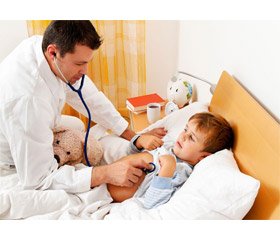Журнал «Здоровье ребенка» 1 (60) 2015
Вернуться к номеру
Structural organization of factors innate immunity in inflammation gastric mucosa in h.pylori-infections in children
Авторы: Abaturov A.E., Gerasymenko O.N. - State Institution «Dnipropetrovsk Medical Academy of the Ministry of Health of Ukraine», Dnipropetrovsk
Рубрики: Педиатрия/Неонатология
Разделы: Справочник специалиста
Версия для печати
Introduction. Colonization of the gastrointestinal tract of H.pylori does not always lead to the development of the pathological process. The response depends on the H.pylori of human immune status, both innate and adaptive, the number of receptors on the surface of the stomach to promote adhesion of the microorganism, and the virulence of H.pylori.Modulation of gene expression induced by H.pylori-associated infections activation image-recognition receptors (pattern-recognition receptors, PRR), before the Toll-like (Toll-like-receptor, TLR) and NOD-like (Nod- like-receptor , NLR, NLR/NOD) receptors and signaling pathways leading to the activation of transcription factors (primarily nuclear transcription factor κB (nuclear factor kappa-light-chain-enhancer of activated B cells, NF-κB). glycoprotein sSD14 - solute form of CD14 is localized in the plasma and provides interaction with epithelial cells of H.pylori of the gastric mucosa. NT-proBNP and sSD14 are also an integral component of the innate immune response to H.pylori infection. LPS (lipopolysaccharide, LPS) - structural components of the outer membrane of Gram-negative bacteria - are among the most significant pathogen-associated molecular structures of microorganisms (pathogen-associated molecular patterns - PAMP), including H.pylori/
The aim of the study was to examine the factor analysis using dynamic structural changes in the state of innate immunity factors in the development of inflammation of the gastric mucosa (GM) in children with H. pylori infection.
Methods. We used molecular genetic methods to determine the level of expression of TLR4, NLRC1/NOD1 biopsy GM and NF-kB in peripheral blood lymphocytes (Research Institute of genetic and immune bases of pathology and pharmacogenetics «Ukraine Medical Stomatological Academy" Poltava). Method ELISA was used to determine the level of serum sCD14 and NT-proBNP.
Results. Using factor analysis studied the dynamics of structural changes in the state of innate immunity factors in the development of inflammation of the gastric mucosa (GM) 128 children with chronic gastroduodenal diseases in the acute stage: 70 (54,7%) patients infected with H. pylori; 58 (45.3%) children the which H. pylori was not detected. Received factors that allow to identify the main structural components of the axis of the expression of innate immunity nonspecific defense mechanisms that determine the development of local inflammation GM (P <0.001). Factor structure of the expression of components of non-specific defense mechanisms that determine the development of local inflammation of the gastric mucosa in children infected with H. pylori, consisted of 5 factors that have the following information relevance and organized by the following factors: I factor - 42.35%; Factor II - 23.66%; III factor - 15,60%; Factor IV - 10.46%; Factor V - 7.94%. Leading among local inflammation of the gastric mucosa factors associated with H.pylori, held a factor that characterizes the activity of nuclear transcription factor NF-κB, suggesting that the leading role of NF-κB-associated signaling pathway during inflammation of the gastric mucosa, which is induced by pathogenic associated molecular patterns of H.pylori. Direct contact of NF-κB activity and content of sCD14 in serum of children with chronic gastroduodenal disease associated with H.pylori may be due to significant influence pathogenesis of H.pylori in lipopolysaccharide inflammation of the gastric mucosa. Group of factors (III, IV, V) with inverse proportional to the level of activity of NF-κB and sCD14 can be described as a receptor group, as it includes factors such as gene expression gene TLR4 and gene NLRC1/NOD1. Finding the factor V antimicrobial peptide NT-proBNP suggests that its activity related products in violation of these receptors. Inversely proportional relationship between the level of excitation of PRR as TLR4, NLRC1 / NOD1 and activity of nuclear transcription factor NF-κB, in all probability, emphasizes receptor-independent NF-κB ways excitation of infection of H.pylori. Factor structure in patients with H.pylori-negative status consisted of two groups of factors inversely proportional to each other. The first «positive» group (I, II factors) containing NT-proBNP and sCD14, we can assume that the main thrust investigated molecular pathways of inflammation in the gastric mucosa, which is not associated with H. pylori is NLRC1/NOD1-dependent antimicrobial products peptide NT-proBNP. The second group of «negative» value factors (IV, V, VI) was organized factor TLR4 gene expression and activity of the transcription factor NF-κB, which makes the TLR4-dependent way with excitation of inflammation of the gastric mucosa in the absence of H.pylori infection.
Conclusions. It is shown that inflammation in patients with with chronic gastroduodenal diseases, unassociated with H.pylori, is determined by two signaling systems, the activity of which is inversely proportional to the ratio of one-to-one: NLRC1/NOD1-associated and associated TLR4- cascades. While the mechanism leading of the gastric mucosa inflammation in children with of H.pylori-associated chronic gastroduodenal disease is receptor-independent activation of the transcription factor NF-κB, while receptor-dependent mechanism to determine more products NT-proBNP.
1. Abaturov A.E, Volosovec A.P., Julish E.I. Iniciacija vospalitel'nogo processa pri virusnyh i bakterial'nyh zabolevanijah, vozmozhnosti i perspektivy medikamentoznogo upravlenija. - H.: OOO «S.A.M.», 2011. - 392 s. Russian
2. Lezhenko G.O., Abaturov O.Є., Pashkova., O.Є. Pantjushenko L.І. Patogenetichne znachennja antimіkrobnih peptidіv u realіzacії antibakterіal'nogo zahistu u dіtej, hvorih na mukovіscidoz. Zdorov'e rebenka. – 2013. - 3(46) 44-49. Ukraine
3. Kawai T, Akira S. The role of pattern-recognition receptors in innate immunity: update on Toll-like receptors. Nat Immunol. 2010;11(5):373-84. doi: 10.1038/ni.1863.
4. Lu YC., Yeh WC, Ohashi PS. LPS/TLR4 signal transduction pathway. //Cytokine. - 2008; 42(2):145-51. doi: 10.1016/j.cyto.2008.01.006.
5. Brandt S., Kwok T.,. Hartig R, König W., Backert S. NF-kappaB activation and potentiation of proinflammatory responses by the Helicobacter pylori CagA protein Proc Natl Acad Sci USA. 2005;102(26):9300-5.
6. Yang ZM, Chen WW, Wang YF. Gene expression profiling in gastric mucosa from Helicobacter pylori-infected and uninfected patients undergoing chronic superficial gastritis. PLoS One. 2012;7(3).e33030. doi:10.1371/journal. pone.0033030.

